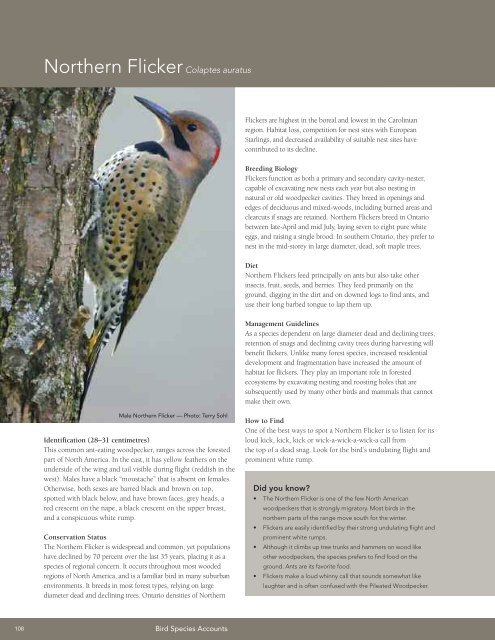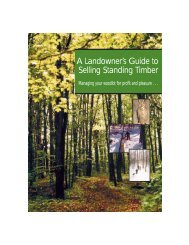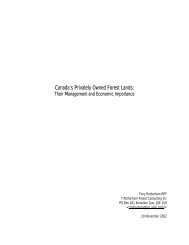A land manager's guide to conserving habitat for forest birds in ...
A land manager's guide to conserving habitat for forest birds in ...
A land manager's guide to conserving habitat for forest birds in ...
Create successful ePaper yourself
Turn your PDF publications into a flip-book with our unique Google optimized e-Paper software.
Northern Flicker Colaptes auratus<br />
Flickers are highest <strong>in</strong> the boreal and lowest <strong>in</strong> the Carol<strong>in</strong>ian<br />
region. Habitat loss, competition <strong>for</strong> nest sites with European<br />
Starl<strong>in</strong>gs, and decreased availability of suitable nest sites have<br />
contributed <strong>to</strong> its decl<strong>in</strong>e.<br />
Breed<strong>in</strong>g Biology<br />
Flickers function as both a primary and secondary cavity-nester,<br />
capable of excavat<strong>in</strong>g new nests each year but also nest<strong>in</strong>g <strong>in</strong><br />
natural or old woodpecker cavities. They breed <strong>in</strong> open<strong>in</strong>gs and<br />
edges of deciduous and mixed-woods, <strong>in</strong>clud<strong>in</strong>g burned areas and<br />
clearcuts if snags are reta<strong>in</strong>ed. Northern Flickers breed <strong>in</strong> Ontario<br />
between late-April and mid July, lay<strong>in</strong>g seven <strong>to</strong> eight pure white<br />
eggs, and rais<strong>in</strong>g a s<strong>in</strong>gle brood. In southern Ontario, they prefer <strong>to</strong><br />
nest <strong>in</strong> the mid-s<strong>to</strong>rey <strong>in</strong> large diameter, dead, soft maple trees.<br />
Diet<br />
Northern Flickers feed pr<strong>in</strong>cipally on ants but also take other<br />
<strong>in</strong>sects, fruit, seeds, and berries. They feed primarily on the<br />
ground, digg<strong>in</strong>g <strong>in</strong> the dirt and on downed logs <strong>to</strong> f<strong>in</strong>d ants, and<br />
use their long barbed <strong>to</strong>ngue <strong>to</strong> lap them up.<br />
Management Guidel<strong>in</strong>es<br />
As a species dependent on large diameter dead and decl<strong>in</strong><strong>in</strong>g trees,<br />
retention of snags and decl<strong>in</strong><strong>in</strong>g cavity trees dur<strong>in</strong>g harvest<strong>in</strong>g will<br />
benefit flickers. Unlike many <strong>for</strong>est species, <strong>in</strong>creased residential<br />
development and fragmentation have <strong>in</strong>creased the amount of<br />
<strong>habitat</strong> <strong>for</strong> flickers. They play an important role <strong>in</strong> <strong>for</strong>ested<br />
ecosystems by excavat<strong>in</strong>g nest<strong>in</strong>g and roost<strong>in</strong>g holes that are<br />
subsequently used by many other <strong>birds</strong> and mammals that cannot<br />
make their own.<br />
Male Northern Flicker — Pho<strong>to</strong>: Terry Sohl<br />
Identification (28–31 centimetres)<br />
This common ant-eat<strong>in</strong>g woodpecker, ranges across the <strong>for</strong>ested<br />
part of North America. In the east, it has yellow feathers on the<br />
underside of the w<strong>in</strong>g and tail visible dur<strong>in</strong>g flight (reddish <strong>in</strong> the<br />
west). Males have a black “moustache” that is absent on females.<br />
Otherwise, both sexes are barred black and brown on <strong>to</strong>p,<br />
spotted with black below, and have brown faces, grey heads, a<br />
red crescent on the nape, a black crescent on the upper breast,<br />
and a conspicuous white rump.<br />
Conservation Status<br />
The Northern Flicker is widespread and common, yet populations<br />
have decl<strong>in</strong>ed by 70 percent over the last 35 years, plac<strong>in</strong>g it as a<br />
species of regional concern. It occurs throughout most wooded<br />
regions of North America, and is a familiar bird <strong>in</strong> many suburban<br />
environments. It breeds <strong>in</strong> most <strong>for</strong>est types, rely<strong>in</strong>g on large<br />
diameter dead and decl<strong>in</strong><strong>in</strong>g trees. Ontario densities of Northern<br />
How <strong>to</strong> F<strong>in</strong>d<br />
One of the best ways <strong>to</strong> spot a Northern Flicker is <strong>to</strong> listen <strong>for</strong> its<br />
loud kick, kick, kick or wick-a-wick-a-wick-a call from<br />
the <strong>to</strong>p of a dead snag. Look <strong>for</strong> the bird’s undulat<strong>in</strong>g flight and<br />
prom<strong>in</strong>ent white rump.<br />
Did you know?<br />
• The Northern Flicker is one of the few North American<br />
woodpeckers that is strongly migra<strong>to</strong>ry. Most <strong>birds</strong> <strong>in</strong> the<br />
northern parts of the range move south <strong>for</strong> the w<strong>in</strong>ter.<br />
• Flickers are easily identified by their strong undulat<strong>in</strong>g flight and<br />
prom<strong>in</strong>ent white rumps.<br />
• Although it climbs up tree trunks and hammers on wood like<br />
other woodpeckers, the species prefers <strong>to</strong> f<strong>in</strong>d food on the<br />
ground. Ants are its favorite food.<br />
• Flickers make a loud wh<strong>in</strong>ny call that sounds somewhat like<br />
laughter and is often confused with the Pileated Woodpecker.<br />
108<br />
Bird Species Accounts

















